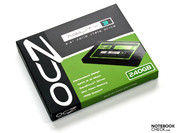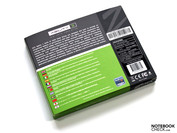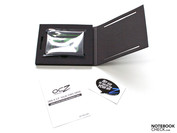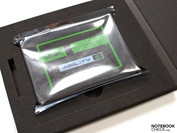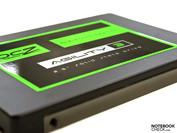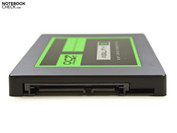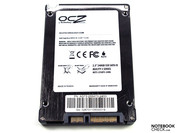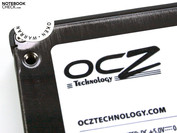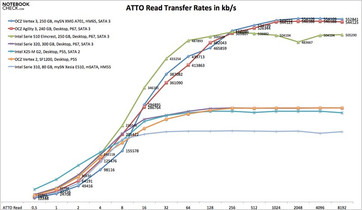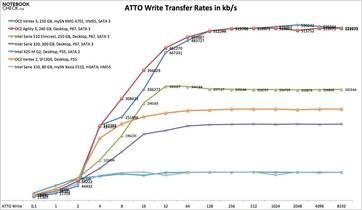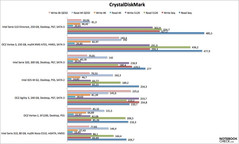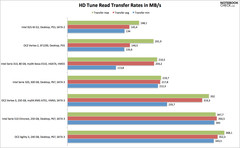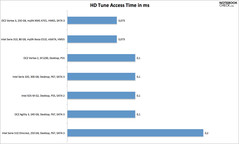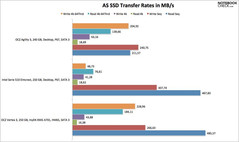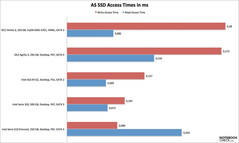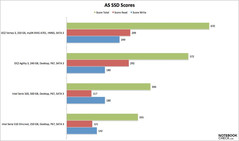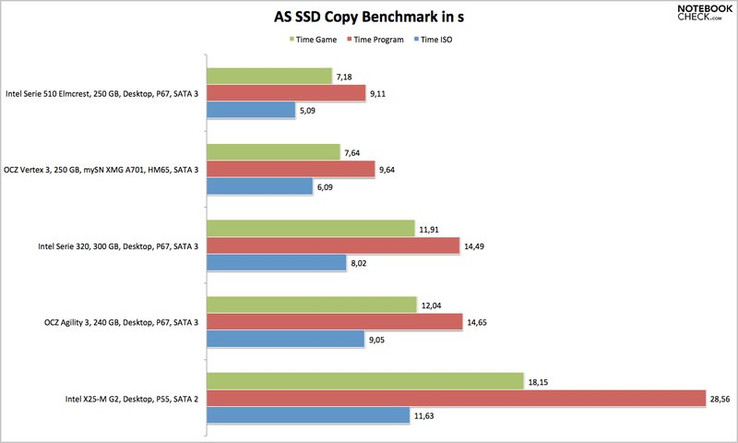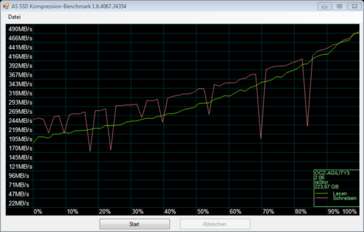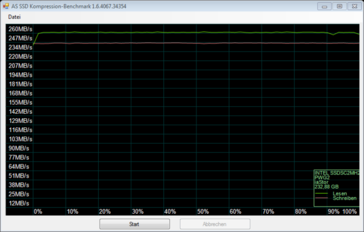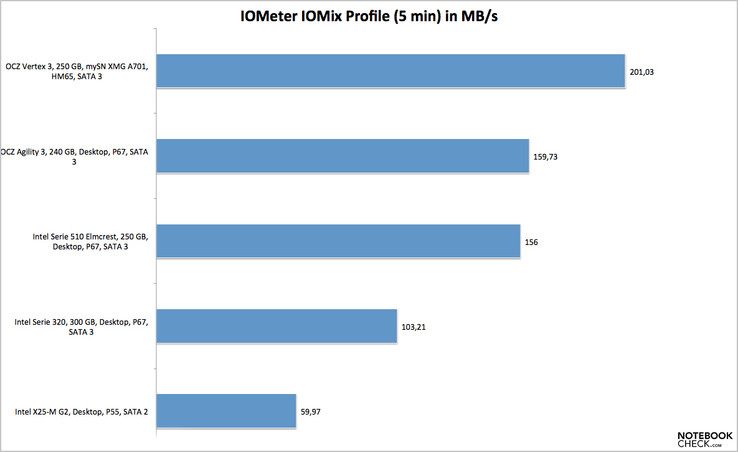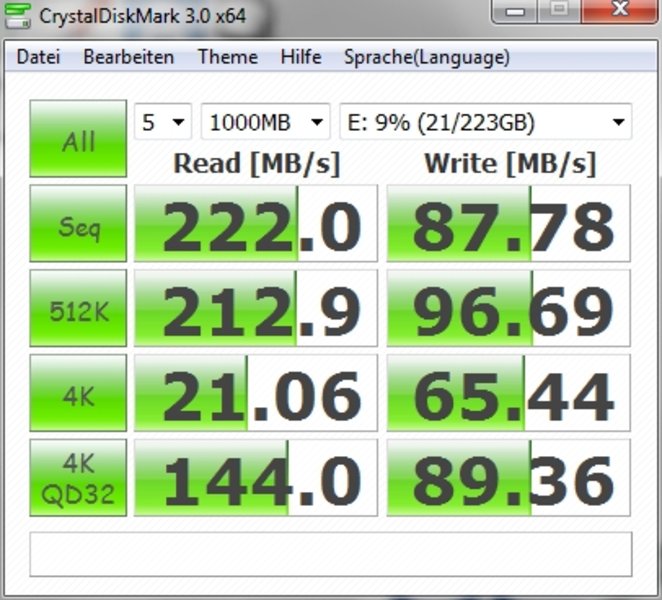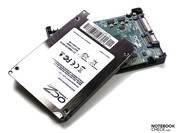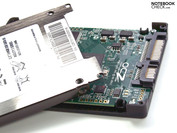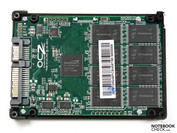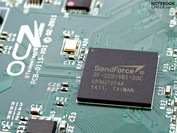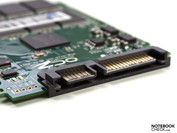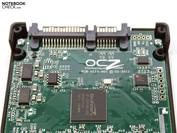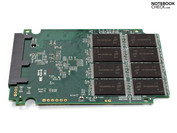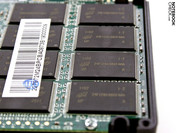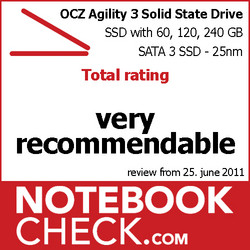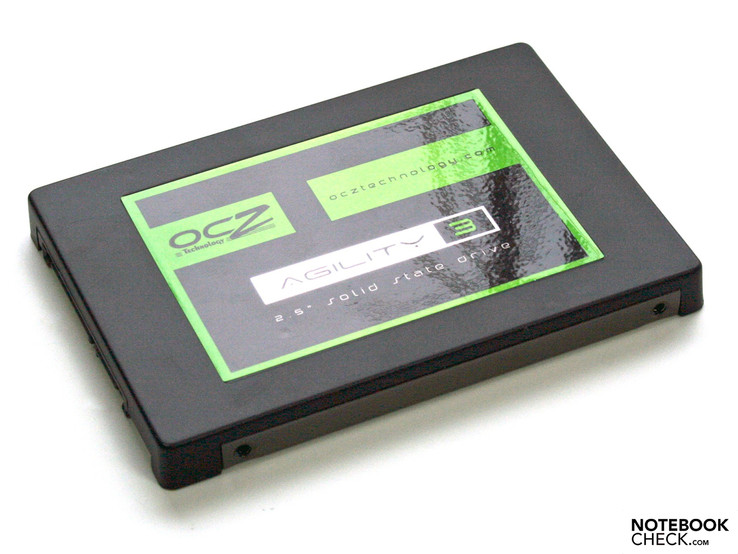Review: OCZ Agility 3 240 GB Solid State Drive (SSD, SATA 3)

After the already reviewed OCZ Vertex 3 Solid State Drive (SSD) the company now also presents the mainstream storage solution OCZ Agility 3, which was not yet shown at the CeBIT 2011 in Hannover. Alike the high-performance-model, the Agility 3 features the new SandForce SF-2281 controller, a capacity of 60, 120, or 240 GByte and SATA III support. Therewith, the maximum transfer rate is 6 Gbit/s. Nevertheless, it differs from the Vertex 3. Nominally, the OCZ Agility 3 is somewhat slower, because it "only" features 45,000 instead of 60.000 IOPS, the firmware is modified and, to keep the price low, the scope of delivery does not include a 3.5-inch bracket for mounting it in a Desktop-PC.
A big difference between the two series is the used NAND flash memory. While the Vertex 3 features synchronous 25-Nanometer NAND, the Agility 3 only comes with asynchronous memory. So, instead of 200 MB/s (Vertex 3) only 50 MB/s are possible per channel, but the cost-efficiency is better. Compared to Solid State Drives with SandForce-Controller from other manufacturers, OCZ products are easily distinguishable. Their independent development of new features and the modification of the firmwire results in an improved performance. Furthermore, the German OCZ forum makes a better customer support possible. Apart from that the TRIM command, garbage collection (GC) and the usual operating systems (Windows, Mac OS X, and Linux) are supported.
According to the marketing, the top model with 240 GByte under review features a maximum transfer rate of 525 MB/s (read) and 500 MB/s (write). Comparing the other models offered, only the entry-level model with 60 GByte writes a little slower (475 MB/s). In our performance tests we used a Desktop-computer with Intel Core i7-2600K processor, Mainboard with Intel P67-chipset, AMD Radeon HD 6870 graphics card and Microsoft Windows 7 Ultimate operating system with installed Service Pack 2. Furthermore, SpeedStep and Hyper-Threading are activated and the newest Intel Matrix Storage driver installed.
The OCZ Agility 3 with 240 GByte is offered in the USA at a non-binding price of 479.99 US-dollar and is therewith 80 US-dollar cheaper than the faster Vertex 3. The difference is similar in the German market. Depending on the retailer the Agility 3 costs about 385 Euro and the Vertex 3 about 425 Euro.
Benchmarks
We start with the read and write tests in 512 KB and 8 GB package size of the ATTO Disk benchmark. Marketing information is typically based on this test, because it usually displays the best transfer rates.
OCZ Technology specify a maximum read rate of 525 MB/s, which our powerful test system even exceeded. We recorded a maximum of 546 MB/s. So, the Agility 3 can reach the level of the Vertex 3, which we, however, tested in an up-to-date laptop from Schenker. As excepted, the transfer rate of small packages up to 8 to 16 MB, is on par with the average of Solid State Drives. Beyond that, the wheat is separated from the chaff and the Intel SSD Series 510 alias Elmcrest cannot keep up with drives from OCZ. Compared to these high-end-models Intel's X25-M and its successor, the Intel SSD Series 320, which achieves a read rate of 285 MB/s, are clearly slower. In plain language, the difference between the OCZ Agility 3 and the Intel SSD Series 320 is 262 MByte per second, that is 40.6 %.
In achieving a maximum write rate of 520 MB/s, the Agility 3 can retain the good impression and again reaches the level of the Vertex 3. The comparable Intel SSD Series 510 cannot keep up with the test model here and is about 35.6 % slower (335 MB/s). Alike the OCZ Agility 3 the Intel's SSD Series 320 is designed for the consumer market. With a maximum of 230 MB/s and, therewith, a clear difference of 55.8 % this Solid State Drive is, e.g., even slower than the older OCZ Vertex 2 and at the same time not really cheaper.
Next we look at the results of CrystalDiskMark, which tests a number of different transfers. But, we will focus on the 4K write and read benchmark, because such operations are usually frequent. Achieving 81 MB/s in writing and 29 MB/s in reading the SSD does well in this test too and the result corresponds to the ATTO Disk Mark: The Vertex 3 SSD is on par and the storage devices from Intel have to admit defeat. The difference to the Intel's SSD Series 510 is about 43 % in writing (46.42 MB/s) in favor of the OCZ Agility 3.
The read-benchmark of HD Tune Pro has not really been developed for Solid State Drives. Nevertheless, the results among themselves can be compared. Our test sample accomplishes an average of 352 MB/s and, so, the first place in our comparison chart. The Vertex 3 (note: in a different test system) does not perform that well in this test and achieving 316 MB/s it is about 10% slower. On the other hand, the Intel SSD Series 510 goes strong here and is only about 2 MB/s behind the OCZ Agility 3 SSD. The Intel SSD Series 320, a consumer solution and successor of the X25-M, only supports transfer via SATA II. So, it performs clearly worse. The average of 217.8 MB/s gives a difference of 38.2 %.
Without doubt, the access times are an important aspect besides the transfer rates. HD Tune features a measurement of the read access time. Achieving 0.1 milliseconds, the OCZ Agility 3 is in the green for an SSD. Only Intel's SSD Series 510 is at 0.2 milli-seconds somewhat defeated. However, subjectively you could not tell. Access times of conventional hard drives range between 16 and 24 milliseconds on average and, so, belong to a different world.
The AS SSD Benchmark is solely designed for modern drives and gives reliable results. Compared to the ATTO Disk Mark the results are partly clearly lower. A useful feature is the measurement of the read and write access time. The test confirms the good result in reading and the result in writing does not need to hide too. However, 0.27 milliseconds are a bit high in comparison.
Compared to the CrystalDiskMark, AS SSD uses data that is clearly harder to compress. Therewith, the Agility 3 is clearly slower than the Vertex 3 in sequential reading. The impact of the asynchronous NAND cells gets obvious here.
After successful measurements, AS SSD also displays a rating in points for reading and writing, and a total score. In the later the OCZ Agility 3 achieves good 572 points and only the faster Vertex 3 Solid State Drive performs better. Interestingly, Intel's SSD Series 510 is defeated and the consumer-oriented Series 320 SSD achieves 180 points in writing and is on par with the Agility 3 here.
Rather hidden under the tab "tools" AS SSD features a small copy benchmark, which should test a typical use. To do so, it moves different types of data and measures the transfer rates. The OCZ Agility 3 is only in the mid-range behind Intel's SSD Series 320, but yet in front of the older X-25M Solid State Drive. The storage medium codenamed Elmcrest wins the first price.
In the compression benchmark from AS SSD it gets obvious that the transfer rates clearly rise the better the data are compressible. On contrary, the screenshot of the Intel 510er SSD shows that its performance is independent of the compression.
Our last benchmark is IOMeter, which features many measurement profiles and can also execute external scripts. We decided to use the profile "IOMix", published by the computer magazine c’t. Alike the copy benchmark from AS SSD it simulates typical use. After running 5 minutes, the test displays an average of 160 MB/s. As a result the OCZ Agility 3 wins the second place behind the faster Vertex 3. The competing model from Intel achieves 156 MB/s and is only slightly beaten in this test.
Performance after Heavy Use
Despite TRIM support we could observer clear drops in the write rates in IOMeter after a period of heavy use (measured with CrystalDiskMark). The sequential write rate dropped from 255MB/s to 88 MB/s. This could also be an emergency mode used by Sandforce SSDs to protect the NAND memory cells, if the drive is extraordinarily stressed. After a Secure Erase (and loss of data), the same performance was observed as at the beginning.
If you consider acquiring a SATA III Solid State Drives, although your computer does actually only support SATA II with a maximum of 3 Gbit/s, the performance difference might be of interest for you. To check this, we also connected the OCZ Agility 3 to a SATA II port in our test system and rerun the benchmarks. In the ATTO Disk benchmark the drive achieves 282 MB/s (read) and 266 MB/s (write). Comparing to the data collected earlier, the differences are 48.4 % (SATA III: 546 MB/s) and 48.9 % (SATA III: 520 MB/s). So, the SSD exhaust the offered bandwidth relatively well, but the difference of the currently used interface is actually abundantly clear.
The results in the PCMark Vantage test and its rating of the storage device is quite similar. Connected to the SATA III port the Agility 3 achieves good 65942 points, i.e a performance gain of 37.7% compared the result of 41088 points when connected to the slower SATA II interface.
The Agility 3 in SATA II mode falls behind the Intel 320 and is clearly defeated in the sequential reading tests and in the PCMark Vantage HDD test.
Again, we also want to deal with the power consumption, because high values will finally have a negative impact on the battery life. Because we do not have sufficient values for a comparison, we used the values published from AnandTech in their review of the OCZ Agility 3 SSD. When idle the hard drive with 240 GByte capacity only draws low 0.5 Watt and is therewith in the green. For comparison: The OCZ Vertex 3 and Intel's SSD Series 510 demand 1 and 0.95, Watt in this scenario. That is about double the energy demand of the Agility 3.
The energy consumption rises with the load and the Agility demands between 1.83 and 3.41 watt depending on the benchmark. Again, the two SATA III alternatives from OCZ and Intel draw more energy in these tests. To summarize, a successful performance of our SATA III test device.
Verdict
Thanks to up-to-date technology and fast transfer rates, the OCZ Agility 3 proves to be an entry-level device to the top range of SSDs. The transfer rates measured at the desktop-PC via SATA III confirm and partly even exceed the marketing information of 525 MB/s (read) and 500 MB/s (write). Further pros, are the low access time and as a result the smooth workflow with short boot times and the low energy demand. This is especially important if used inside a Netbook.
Finally, also the price should not be neglected. Besides models with a capacity of 60 and 120 GByte, also a 240 GByte model of the OCZ Agility 3, just like the one we reviewed, is offered. Currently, our test model costs 385 euro. That is 1.60 euro per GByte. The fast OCZ Vertex 3 (240 GByte) is currently offered for 425 Euro, which gives 1.77 euro per GByte. Intel's SSD Series 510 (250 GByte) and 320 (300 GByte) have a price-to-GB rate of 1.82 and 1.50 Euro.
To summarize, the performance and the modern technology of the OCZ Agility 3 are convincing. Users who frequently operate with data difficult to pack should rather buy one of the Intel solutions or the more expensive Vertex 3.




